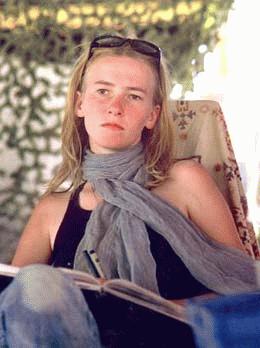On March 16, 2003, at approximately 4:45 p.m., an Israeli army bulldozer runs over Rachel Corrie, a 23-year-old peace activist with the International Solidarity Movement (ISM), who stood in the way of the machine that was preparing to demolish a Palestinian home. She was rushed to the emergency room of the Najjar Hospital in Gaza where she died from her injuries before 5:20 p.m.
An Olympia Peace Activist
Rachel Corrie was born and raised in Olympia and attended Evergreen State College. Corrie worked in the Olympia Movement for Justice and Peace, and at BHR, a local Olympia mental health clinic. She volunteered at the Evergreen Labor Center, was active in SEIU (Service Employees International Union) No. 1199NW, a Washington health care union, and played a major role in organizing a peace and justice networking and strategies conference in Olympia in the spring of 2002.
She took winter quarter off from school to go to the West Bank, and later the Gaza Strip as a volunteer with the International Solidarity Movement (ISM), an international group of activists opposed to Israel's military occupation of Palestinian territory. She had planned to return to Washington and finish her studies at Evergreen that spring.
According to witnesses, Rachel and seven other ISM activists were in the Hi Es Salam area of Rafah, Gaza, protesting and attempting to prevent the destruction of a Palestinian home by the Israeli military, which had two bulldozers and a tank at the location. For two hours, she and the other activists were acting as international monitors and occasionally physically blocking the bulldozers to prevent them from demolishing the home.
Eyewitness Account
In a statement made on March 16, 2003, Richard Purssell, an ISM volunteer from Brighton, England, who witnessed the incident, said that the bulldozer approached Rachel, who was wearing an orange fluorescent jacket with reflective stripes, with its blade down and was scooping up soil as it came towards her. He continued:
"Rachel climbed up the pile and at the one stage was looking directly into the cabin window. There is no way the driver could not have known she was there. The bulldozer continued driving forwards and Rachel turned round to face in my direction. She began to slide down the pile, however as soon as her feet touched the ground for some reason she fell forward. Maybe her foot was caught or the weight of the soil pushed her forward. At this point the panic on her face was obvious. We were all shouting, screaming and gesturing by this stage. The earth was totally pushed over her, engulfing her. She was lost to my sight. I noticed that the driver had not lifted the blade. The machine rolled straight over her and continued a little way. It then reversed over her and retreated about 20 metres. Rachel was left in its tracks, bleeding from the mouth and twisted" (International Solidarity Movement website).
The Israeli daily newspaper, Haaretz, reported on March 17, 2003: Army sources said the demolitions were meant to prevent sabotage along the Philadelphi road parallel to the Egyptian border. The sources said the bulldozer driver deviated from the track and apparently was moving a block of concrete that hit the woman.
A memorial for Corrie was held at Percival Landing in downtown Olympia on the evening of March 16th. A moment of silence was held at a peace vigil in Washington D.C. that night, and 1,000 people attended a public memorial service at Evergreen State College on March 22. Britain's Guardian newspaper reported that Israeli forces used tear gas and stun grenades to disrupt a memorial at the site of Corrie's death on March 18, 2003.

